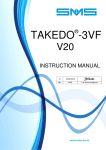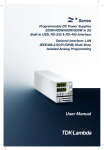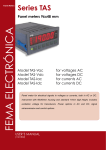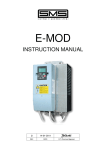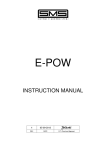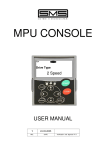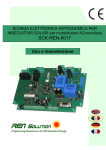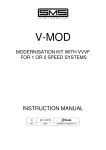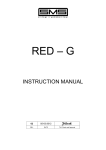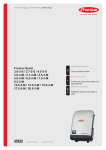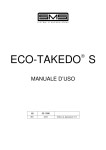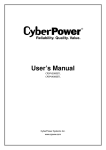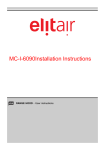Download Takedo Energy user manual
Transcript
Takedo Energy ® http://www.sms.bo.it USER MANUAL 2 01-02-2013 REV. DATE R.T. Check and Approval INDEX 1 - INTRODUCTION ......................................................................... ....Page 3 2 - SAFETY WARNINGS AND CAUTIONS .........................................Page 3 3 - TECHNICHAL SPECIFICATIONS ..................................................Page 3 4 OPERATION PRINCIPLE ...............................................................Page 3 5 - CONNECTIONS................................................................................Page 4 6 - APPLICATION DIAGRAM ...............................................................Page 5 7 - PROGRAMMING AND MONITORING KEYPAD (OPTION) ...........Page 6 8 - CHECKS AND MAINTENANCE ......................................................Page 8 9 - DIMENSIONS AND WEIGHT ..........................................................Page 9 VACON DECLARATION OF CONFORMITY ...................................Page 10 2 TAKEDO ENERGY USER MANUAL Release 2 dated 01-02-13 1 – INTRODUCTION TAKEDO ENERGY is a device able to recover, directly on the mains, the energy normally dissipated by the braking resistor in lift systems driven by an inverter. Its built-in LCL filter can reduce the current harmonic contents, to be compliant to the EN 12015 standard, for low frequency harmonics. 2 – SAFETY WARNINGS AND CAUTIONS Detailed informations are available inside the VACON original manual (NXP series), on www.vacon.com website. Read carefully this manual before powering the unit, following the procedures step by step. 2.1 CAUTIONS To avoid damaging the inverter in the event of prolonged stoppages with no power supply, before restarting the drive, connect it to the power supply for at least 1 hour, with no commands to the lift system, in such a way as to recharge the bus capacitors. If the inverter has been idle for more than one year, supply it for 1 hour with a level of voltage 50% lower than the nominal input voltage, and then supply it with the nominal input voltage for 1 hour. 3 –TECHNICAL SPECIFICATIONS Input voltage 3 ~ 400V +/- 15% Max. output current 4,3A (Size 4.3) 12A (Size 12) Max. power regenerated 3000W (Size 4.3) 8000W (Size 12) Harmonic content (THD) 16% Stand-By consumption 3W Working duty-cycle 100% FAULT OPTION relay (with NXOPTA2 Board only) Switching Power: Minimum switching load: 24Vdc/8A 250Vac/8A 125Vdc/0,4A 5V/10mA 4 – OPERATION PRINCIPLE When the lift motor is pulled by the load (for example running upward with empty car or downward with full load in the car, or in any case of favorable weight) all the energy of the excess weight that descends to the ground floor must be dissipated to prevent the escape of the weight itself. Normally in a lift system with speed controlled by an inverter, all the energy generated by the motor driven by the load is dissipated via a braking resistor, which converts the energy into heat. The regenerated energy depends, besides the weight, on the system type, on the motor type, on the gear type, etc. .. TAKEDO ENERGY is a device which “returns” the excess energy to the mains: in this way, rather than heat the environment, it reduces the consumption, since the recovered energy feeds the other loads of the system: operation, brake, car light, etc..; only the excess is fed back into the supply network for supplying other building utilities. With the objective of ensuring maximum energy savings, TAKEDO ENERGY has an internal system to reduce power consumption in stand-by from about 19W to 3W. After a minute from the motor contactors dropping, the system turns off; it will turn on again, ready to recover energy, at the next activation of a new command. TAKEDO ENERGY USER MANUAL Release 2 dated 01-02-13 3 5 –CONNECTIONS 5.1 WARNINGS 1 - Do not power the device without having done the EARTH cable connection. 2 - To increase the security of the device (especially against over voltages due to weather events), three fuses (one for each phase) are provided in series with the input terminals of the mains supply (their size depends on the device size). 3 - The device must be connected as indicated in 5.3 and 5.4, following the application diagram in Chapter 6. An incorrect connection may cause damages. 4 - Perform the wiring as described in Section 5.2 to avoid EMC problems. 5.2 WIRING RULES In order to avoid problems related to EMC, wiring must be treated according to the following guidelines : 1 - The cable connection between the bus of the main inverter and TAKEDO ENERGY should be as far away as possible from any other wiring (although shielded) and never parallel. If the wires are crossed, should be arranged to form a 90 degrees angle. 2 - The earth and the shield of the cable that connects TAKEDO ENERGY to the main inverter BUS must be connected, inside the main inverter, to the same terminal in which the building earth cables are connected. 3 - The cable that connects TAKEDO ENERGY to the mains must be far away from the power cable that connects the main inverter to the motor and from the cable that connects the braking resistor to the main inverter (50 cm at least). 5.3 POWER CONNECTIONS MAINS wiring The mains must be connected to terminals L1-L2-L3 of TAKEDO ENERGY, following the drawing shown at Chapter 6. It is not necessary to respect the phase sequence. BUS wiring The terminals B + and B-must be connected to the BUS of the main inverter. Should NOT be connected in parallel with the braking resistor. Normally the inverters have a resistor terminal connected to the positive terminal of the BUS. The negative of the BUS is usually a terminal with no other connections. With motor inverter powered , between the positive and negative BUS terminals there are 500Vdc ÷ 650Vdc. EARTH wiring TAKEDO ENERGY has two earth wires that must be both connected : one on the mains EARTH cable and the second one on the cable connected to the motor inverter BUS. SHIELD The only shield to be connected is on the cable connected to the motor inverter BUS. Please read carefully the notes in section 5.2 5.4 CONTROL CONNECTIONS 4 RUN command INPUT to terminals RUN – RUN, to be connected to a “voltage free” contact of a run contactor. The command must be activated BEFORE the lifting of the mechanical brake and disabled AFTER the dropping of the mechanical brake. FAULT relay (OPTION) If the NXOPTA2 Board is provided, at output terminals 21-22-23 is available a switching contact of a relay, powered when the TAKEDO ENERGY is ready to run. In case of malfunction or failure this relay is disabled. TAKEDO ENERGY USER MANUAL Release 2 dated 01-02-13 6 – APPLICATION DIAGRAM MAINS POWER LINE 3 x 400V (+/- 15%) IMPORTANT If the existing motor inverter is provided with an INSIDE FILTER, you must install an external added filter, so that the connection of TAKEDO ENERGY can be carried out as shown in the figure. FILTER * PE L1 L2 L3 CABLE 4x2,5 TAKEDO ENERGY PE L1 L2 L3 MAIN INVERTER PE B- B+ R- U V W PE B+ BSHIELDED CABLE 3x2,5 NOTE (1) RUN RUN CABLE 2x0,75 OPTIONAL contact, available with NXOPTA2 Board only 22 21 Contact to inform the controller of the TAKEDO ENERGY failure. 23 FAULT relay, powered when TAKEDO ENERGY is ready to run. TAKEDO ENERGY USER MANUAL Release 2 dated 01-02-13 MOTOR NOTE (1) The braking resistor has not to be eliminated. 5 7 –PROGRAMMING AND MONITORING KEYPAD (OPTION) The keypad for control and configuration is not included in the TAKEDO ENERGY, but it is supplied as an option because, for the operation of the device no parameterization is required. About the use of the keypad please refer to the VACON original manual (NXP series), on www.vacon.com website. The menus available are: M1=Monitor M5=Fault History M2=Parameters M6=System Menu M4=Active Faults M7=Expander Boards Each menu contains submenus, which can be on several levels. To access the submenus, press the key, then use the +/- keys to show the various items; to quit the submenu, press the key. KEY TO SYMBOLS CONTAINED IN MENUS AND SUBMENUS: M= Menu (internal modes G,V,P,H,F) G= Group (internal modes V,P) V= Read only item H= Fault history P= Modifiable parameter F= Active faults 7.1 M1 = MONITOR This menu allows the display of variables and data during operation of TAKEDO ENERGY. The table below shows only the main variables significant for the application. Indice Descrizione V1.1 V1.2 V1.4 V1.5 V1.6 V1.7 V1.8 Tensione bus C.C. / DC-link Voltage Corrente Totale / Total Current Potenza Rigenerata / Regenerated Power Corrente Attiva / Active Current Corrente Reattiva / Reactive Current Tensione di rete / Supply Voltage Frequenza di rete / Supply Frequency DIN1,DIN2,DIN3 (not used) V1.9 DIN4 (Run), DIN5,DIN6 (not used) V1.10 DO1(n.u), DAO1 V1.3 Unità V A Indice Descrizione V1.11 R01 (Fault), R02 (Contactor) V1.13 Rif. Ingr. Analogico / Analogic input % kW V1.14 Inseguitore / Follower % % % V Hz V1.15 V1.16 V1.17 V1.18 V1.19 A A A °C % Corrente fase U / U Phase Current Corrente fase V / V Phase Current Corrente fase W / W Phase Current Temp inverter / Unit temperature Rif. Tensione DC / Ref. DC Voltage Rif. Corrente Reattiva / Ref. V1.20 Reactive Current V1.21 Multimonitor Another useful display can be found inside the menu M6 - S6.8.2.1 = MWH Counter. This monitor shows the energy in kWh or MWh regenerated from the device. The value shown will have negative sign, because is energy recovered and not consumed. 7.2 M2 = PARAMETERS There are no parameters that normally require changes. ATTENTION, changing certain parameters can affect product reliability. Before changing any parameter, please contact SMS. 6 Unità TAKEDO ENERGY USER MANUAL Release 2 dated 01-02-13 % 7.4 M4 = ACTIVE FAULTS AND WARNINGS Listed below are the most common fault messages. Be careful not to reset the alarm or fault without first having investigated the problems that caused the protection mechanism to cut in. Always deselect the run command before resetting any fault. Code 1 2 5 7 8 9 3 10 11 13 14 16 22 23 25 26 32 36 37 38 39 40 41 52 54 Description Overcurrent: current 4 times the nominal value detected at the inverter output. Remedies / Indications Check the condition of cables connected to L1,L2,L3. Check insulation of LCL filter. Check that during the main inverter braking Overvoltage: bus voltage is too high. phase, the voltage between B + and B-do not exceed 800Vdc. Charge switch: The charge switch is open when Reset the fault and restart . If the fault happens the drive is in running. again, contact SMS. Saturation trip: several potential causes, Cannot be reset from the keypad. Switch off including a faulty component. power and don’t reconnect it. Contact SMS. System error: -Component damaged Reset the fault and restart . If the fault happens -Malfunction. again, contact SMS. Check that the voltage input to the inverter is Undervoltage: BUS voltage is too low. correct and steady. Power stage faults : Check the power cables on the input/output sides Detection of fault in power connections (input or and/or the insulation of LCL filter. output phase missing, earth fault, etc.). Temperature inverter undertemperature (-10°C) Make certain the air flow around the drive is inverter overtemperature (+90°C) sufficient to cool the heat sink and/or check for motor overtemperature. possible motor overload. EEPROM “Checksum” error: Reset the fault and restart . - Parameter recovery failed If the fault happens again, contact SMS. - Damaged or malfunctioning component Microprocessor watch-dog error: Reset the fault and restart. - operational fault If the fault happens again, contact SMS. - component failure Start up prevented: Cancel prevention of inverter start-up. Start-up of the inverter has been impeded. Fan not working Contact SMS. Control unit: The control unit can’t control the Replace the control unit. power unit and vice versa. Device changed: Optional board or control unit Reset changed. Device added: An optional board or power unit Reset with different nominal rating has been added. Remove device: An optional board or power unit Reset has been removed. Device unknown: Reset Unknown optional board or drive. Check device sizing. IGBT temperature: IGBT Inverter Bridge Reduce the current limit of the device (requires overtemperature protection has detected a short the keypad). Check the correct operation of the term too high overload current. cooling fan. Keypad communication error: The connection Check keypad connection and possible keypad between the control keypad and the frequency cable. converter is broken. Slot error: Optional board or connection slot Check board and slot faulty. Contact SMS. . If other types of fault should occur, please contact SMS. TAKEDO ENERGY USER MANUAL Release 2 dated 01-02-13 7 7.5 M5 = FAULT HISTORY The caption H1→Hx appears under the menu. This indicates how many faults are memorized. Up to 30 faults can be memorized and displayed chronologically in reverse order (most recent fault displayed first). Pressing the key when viewing the fault code, opens the "Instant fault data register", in which the values of several key variables are saved (e.g. output frequency, motor current, motor torque, etc.) as they occur. Press the or keys to scroll this register. To reset faults, the enter (ENTER) key must be pressed and held for at least 3 seconds. 7.6 M6 = SYSTEM MENU The caption S1→S11 appears under the menu. This means there are 11 submenus. S6.1 Language Setting: ITALIAN / ENGLISH / FRENCH / GERMAN. 8 – CHECKS AND MAINTEINANCE To ensure long service life and smooth operation of the drive, carry out the following checks at regular intervals. Always isolate the drive from the power supply and make certain the keypad is off before proceeding. 1- Remove the dust that collects on the cooling fans and on the control circuit board, preferably by means of compressed air or using a vacuum cleaner. 2- Check that there are no screws loose at the power or control terminals. 3- Check that inverter function is <<normal>> and there is no abnormal overheating. 8.1 TEST MEGGER Insulation tests are normally not required on TAKEDO ENERGY. If necessary, you must disconnect the terminals L1, L2, L3, B + and B-and short circuit them together, checking the insulation between this node and ground. Do not perform the test on the control circuits. 8 TAKEDO ENERGY USER MANUAL Release 2 dated 01-02-13 9 – DIMENSIONS AND WEIGHT SIZES Max Rigenerated Power (kW) Width (mm) Width with handles (mm) Height (mm) Depth (mm) Weight (kg) TAKEDO ENERGY 4.3 3,00 394 480 520 180 22,5 TAKEDO ENERGY 12 8,00 394 480 520 180 35 FIXING DRAWING Fix box top with n.2 hook rawl plugs Fix handle to plate with n.2 M6 hex screws Fix handle to plate with n.2 M6 hex screws For further information and advice contact: SMS SISTEMI e MICROSISTEMI s.r.l. (Gruppo SASSI HOLDING) Cap. Soc. 260.000 i.v. Via Guido Rossa, 46/48/50 40056 Crespellano BO R.E.A 272354 CF - Reg. Imprese Bo 03190050371 P.IVA IT 00601981202 Tel. : +39 051 969037 Fax : +39 051 969303 Technical Service: +39 051 6720710 Website : www.sms.bo.it E-mail : [email protected] TAKEDO ENERGY USER MANUAL Release 2 dated 01-02-13 9 FIXING DRAWING Fix box top with n.2 hook rawl plugs Fix handle to plate with n.2 M6 hex screws Fix plate to base with n.3 M5 screws 10 Fix handle to plate with n.2 M6 hex screws Fix plate to base with n.3 M5 screws TAKEDO ENERGY USER MANUAL Release 2 dated 01-02-13










![取扱説明書 [PDF形式]](http://vs1.manualzilla.com/store/data/006529707_2-d2d06ea7976a0e2bf51dba0efe3098e9-150x150.png)
